Copyright issues encompass a range of topics including fair use, licensing, and ownership, each playing a vital role in the protection of creative works. Fair use allows limited use of copyrighted material without permission, guided by specific criteria, while licensing involves negotiating terms with copyright holders for broader usage rights. Understanding copyright ownership is essential, as it grants creators exclusive rights and defines how their work can be utilized and monetized.
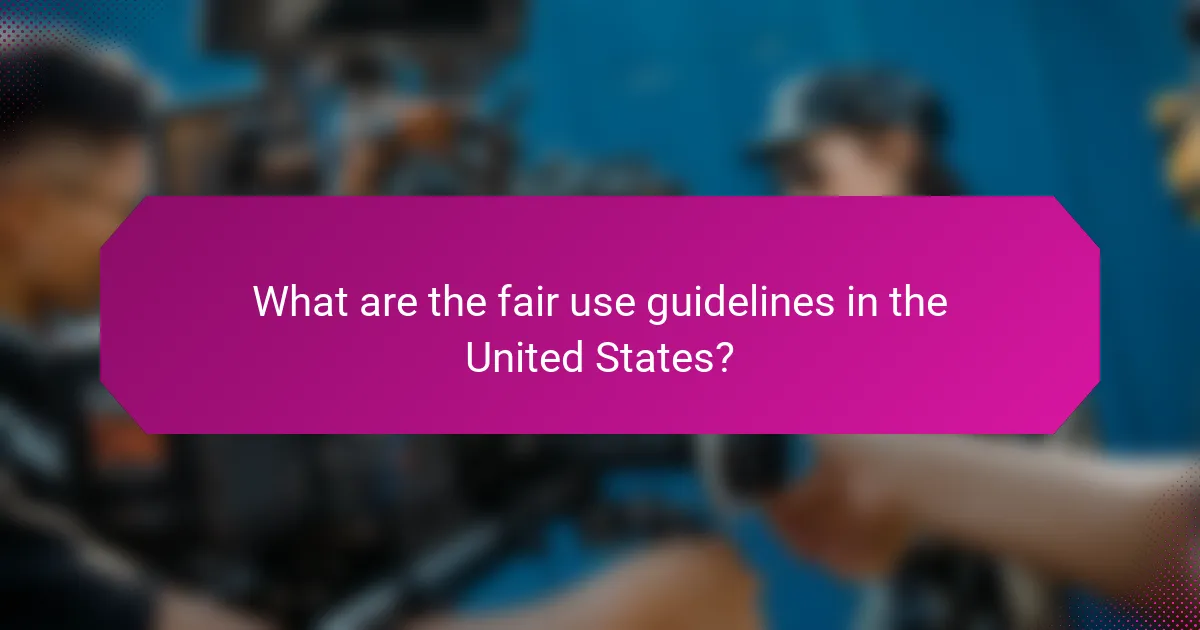
What are the fair use guidelines in the United States?
The fair use guidelines in the United States allow limited use of copyrighted material without permission from the copyright owner. These guidelines are based on four key factors that help determine whether a specific use qualifies as fair use.
Purpose and character of use
The purpose of the use is a critical factor in determining fair use. Uses that are educational, non-profit, or transformative—meaning they add new expression or meaning—are more likely to be considered fair. Conversely, commercial uses that do not add new insights may not qualify.
For example, a teacher using a short video clip in a classroom setting for educational purposes is more likely to be protected under fair use than a company using the same clip in a promotional advertisement.
Nature of the copyrighted work
The nature of the copyrighted work also plays a role in fair use determinations. Published works and factual content are generally more likely to be considered fair use compared to unpublished or creative works. This is because the public interest in accessing factual information is often deemed higher.
For instance, using a portion of a scholarly article for research purposes may be seen as fair use, while using a song from a popular album for a commercial project would be less likely to qualify.
Amount and substantiality used
This factor examines both the quantity and quality of the material used. Using a small excerpt from a work is more likely to be considered fair use than using a significant portion. However, even a small amount can be deemed excessive if it constitutes the “heart” of the work.
As a guideline, using a few sentences from a book for commentary may be acceptable, while using an entire chapter would likely not be. Always consider the context and significance of the portion used.
Effect on the market value
The final factor assesses whether the use negatively impacts the market value of the original work. If the use could substitute for the original and harm its market, it is less likely to be considered fair use. This includes whether the new use competes with the original work.
For example, if a website posts entire articles from a newspaper without permission, it could harm the newspaper’s sales, making that use less likely to qualify as fair use. In contrast, a review that quotes a few lines from the article is less likely to affect its market value.
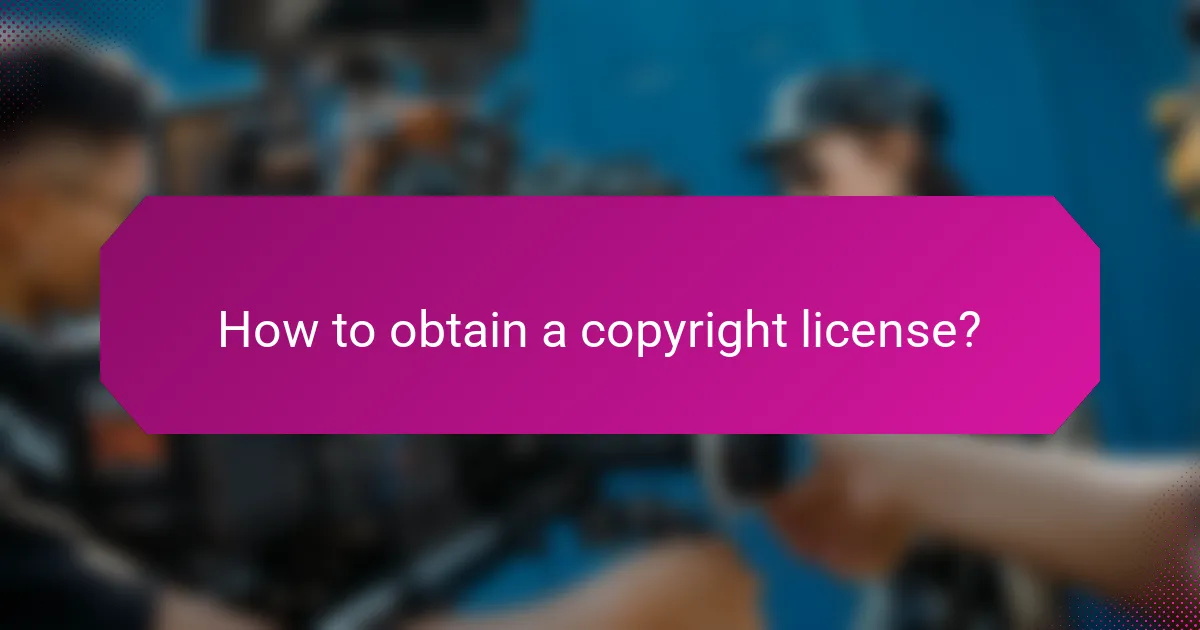
How to obtain a copyright license?
To obtain a copyright license, you need to seek permission from the copyright holder or use a licensing agency. This process involves understanding the specific rights you need and negotiating terms that suit both parties.
Contacting copyright holders
Reaching out to copyright holders is a direct way to obtain a license. Identify the owner of the work, which could be an individual, a company, or an organization, and gather their contact information. A clear and concise request outlining your intended use will facilitate the process.
When contacting copyright holders, be prepared to discuss the scope of your use, duration, and any potential compensation. This transparency can help in negotiating favorable terms.
Using licensing agencies
Licensing agencies can simplify the process of obtaining copyright licenses by acting as intermediaries. These agencies often have established relationships with copyright holders and can provide a range of licensing options for various types of works.
Using a licensing agency may involve paying a fee, but it can save time and ensure compliance with copyright laws. Examples of well-known licensing agencies include ASCAP for music and the Copyright Clearance Center for written works.
Understanding licensing terms
Understanding licensing terms is crucial to ensure that you comply with the agreement. Licensing agreements can vary widely in terms of duration, geographic scope, and usage rights. Pay attention to whether the license is exclusive or non-exclusive, as this will affect your ability to use the work.
Before finalizing any agreement, review the terms carefully and consider seeking legal advice if necessary. Common pitfalls include misunderstanding the limitations of the license or failing to secure rights for all intended uses.
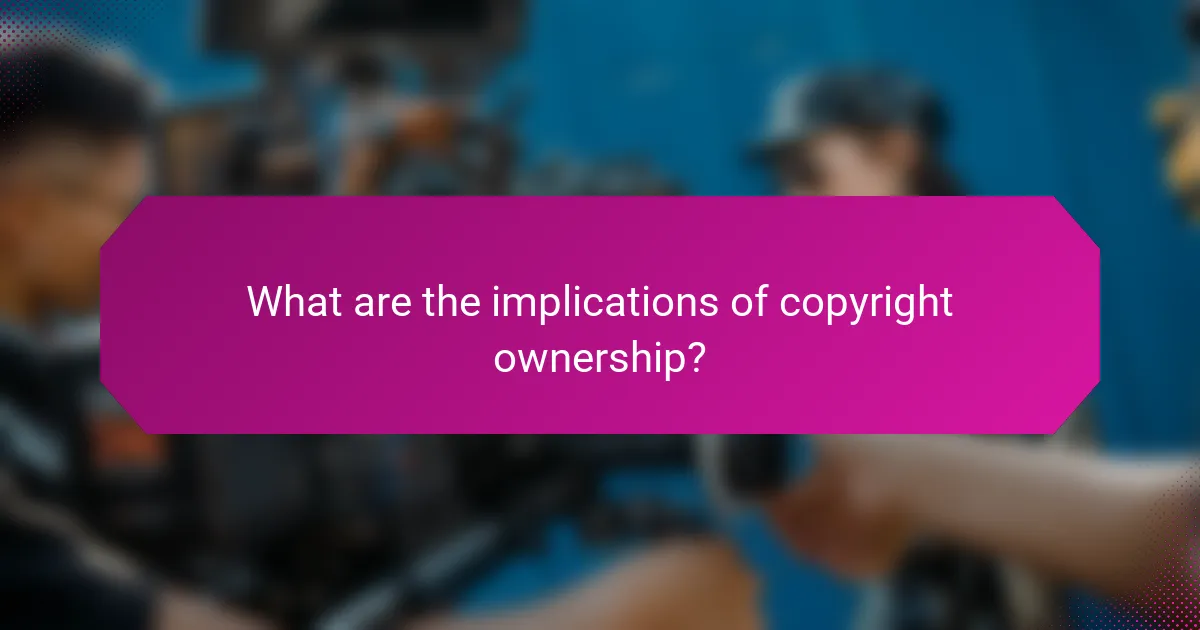
What are the implications of copyright ownership?
Copyright ownership grants the creator exclusive rights to their work, impacting how it can be used, distributed, and monetized. Understanding these implications is crucial for creators and users alike, as it defines the boundaries of legal use and potential infringement.
Rights of the copyright owner
The copyright owner has several key rights, including the right to reproduce, distribute, perform, display, and create derivative works based on the original. These rights enable the owner to control how their work is used and to benefit financially from it. For example, a musician can decide who can perform their song and under what conditions.
Additionally, copyright owners can license their work to others, allowing for specific uses while retaining ownership. This can include granting permission for adaptations or commercial use, often in exchange for royalties or fees.
Transfer of copyright ownership
Copyright ownership can be transferred through various means, such as assignment or licensing agreements. An assignment involves the complete transfer of rights from the original owner to another party, while licensing allows the original owner to retain ownership while granting specific usage rights to others.
When transferring copyright, it is essential to document the agreement clearly to avoid disputes. This can include specifying the scope of use, duration, and any compensation involved. For instance, a photographer may license their images for a specific campaign while retaining the copyright for other uses.
Duration of copyright protection
The duration of copyright protection varies by jurisdiction but typically lasts for the life of the author plus several decades, often 70 years in many countries. For works created by corporations, the duration may be shorter, usually around 95 years from publication.
It is important to be aware of these timeframes, as they determine when a work enters the public domain and can be used freely. For example, a book published in the 1920s may now be in the public domain, allowing anyone to reproduce it without permission.
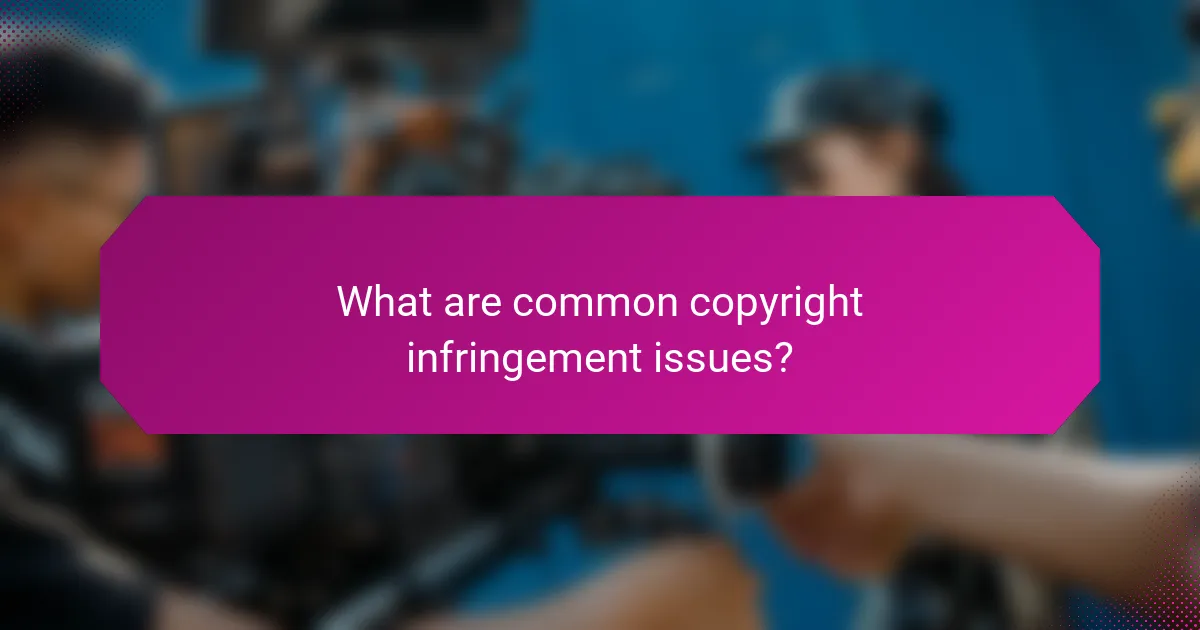
What are common copyright infringement issues?
Common copyright infringement issues include unauthorized reproduction, public performance violations, and derivative works concerns. These issues arise when individuals or entities use copyrighted material without permission, potentially leading to legal consequences.
Unauthorized reproduction
Unauthorized reproduction occurs when copyrighted material is copied without the owner’s consent. This can include printing books, duplicating music, or reproducing artwork. Even seemingly minor reproductions, such as sharing digital images online, can lead to infringement claims.
To avoid unauthorized reproduction, always seek permission from the copyright holder before using their work. Consider using licensed materials or works that fall under public domain to mitigate risks.
Public performance violations
Public performance violations happen when copyrighted works are performed in public without authorization. This includes playing music at events, showing films in public spaces, or staging theatrical performances. Such actions typically require a license from the copyright owner or a performing rights organization.
To ensure compliance, obtain the necessary licenses before any public performance. Familiarize yourself with local regulations regarding public displays of copyrighted works, as requirements can vary by country.
Derivative works concerns
Derivative works concerns arise when someone creates a new work based on an existing copyrighted piece without permission. This includes adaptations, translations, or modifications of the original work. Even if the new work is significantly different, it may still infringe on the original copyright.
To avoid issues with derivative works, always seek permission from the original creator before proceeding with adaptations. If you are unsure whether your work qualifies as a derivative, consult a legal expert in copyright law.
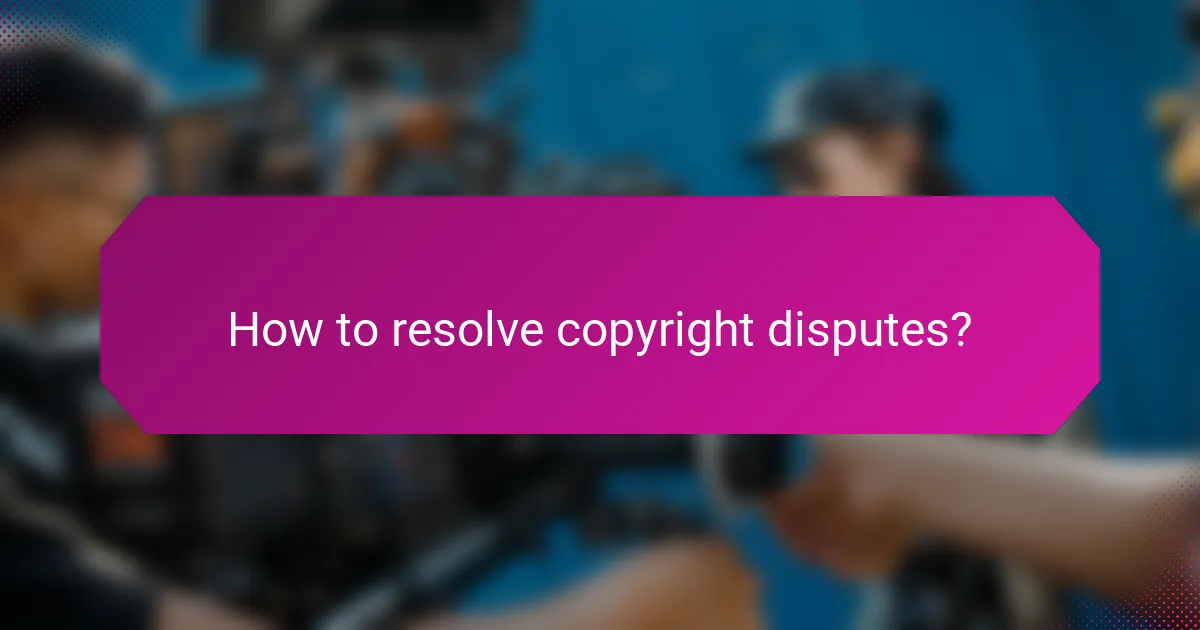
How to resolve copyright disputes?
Resolving copyright disputes typically involves negotiation, legal proceedings, or alternative dispute resolution methods. The approach you choose can significantly impact the outcome, costs, and time involved.
Mediation and arbitration options
Mediation and arbitration are effective alternatives to litigation for resolving copyright disputes. Mediation involves a neutral third party who facilitates discussions between the parties to reach a mutually acceptable solution. Arbitration, on the other hand, is a more formal process where an arbitrator makes a binding decision based on the evidence presented.
These options can save time and reduce legal costs compared to traditional court proceedings. Many copyright disputes can be resolved through mediation, which allows for more flexible solutions tailored to the parties’ needs.
Litigation processes
If mediation or arbitration fails, litigation may be necessary to resolve copyright disputes. This process involves filing a lawsuit in a court, where a judge or jury will determine the outcome based on the evidence and arguments presented. Litigation can be lengthy and expensive, often taking months or years to reach a resolution.
Parties should consider the potential costs, including attorney fees and court expenses, as well as the emotional toll of a prolonged legal battle. In the U.S., copyright cases are typically filed in federal court, while other countries may have different jurisdictions and regulations.
Settlement agreements
Settlement agreements are often reached before or during litigation, allowing parties to resolve their disputes without a trial. These agreements can include terms such as licensing arrangements, monetary compensation, or changes to the disputed work. Settlements can provide a quicker resolution and help maintain relationships between the parties.
When considering a settlement, it’s essential to ensure that the terms are clear and legally binding. Parties should consult legal counsel to draft an agreement that protects their interests and complies with relevant copyright laws.

What are the differences between copyright and trademark?
Copyright and trademark are distinct forms of intellectual property protection. Copyright safeguards original works of authorship, while trademarks protect symbols, names, and slogans used to identify goods or services.
Nature of protection
Copyright protects the expression of ideas, such as books, music, and films, granting the creator exclusive rights to reproduce, distribute, and display their work. In contrast, trademark protection focuses on preventing consumer confusion by safeguarding brand identifiers like logos and brand names.
Copyright lasts for the life of the author plus several decades, typically around 70 years, while trademarks can last indefinitely as long as they are in use and renewed. This fundamental difference affects how creators and businesses manage their intellectual property.
Scope of rights
With copyright, the rights include reproduction, adaptation, and public performance of the work. Trademark rights, however, encompass the exclusive use of the mark in commerce, preventing others from using a similar mark that could confuse consumers.
For example, an author can publish a book and control its distribution, while a company can prevent others from using a similar logo that might mislead customers about the source of a product. Understanding these scopes is crucial for effective IP management.
Registration and enforcement
Copyright protection is automatic upon creation, although registering with the relevant authority can enhance enforcement options. Trademark registration, on the other hand, is necessary to establish legal rights and provide nationwide protection in the United States.
Failure to register a trademark can lead to challenges in enforcing rights, as unregistered marks may have limited protection. Businesses should consider registration to secure their brand identity and avoid potential conflicts.
